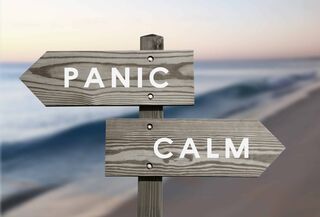Anxiety
A First Step in Overcoming Panic Attacks
You might be paying too much attention to body sensations.
Posted July 25, 2021 Reviewed by Jessica Schrader
Key points
- Panic attacks are common, but can be extremely scary, especially when they occur in unexpected situations.
- People with panic attacks can be on alert, frequently checking their bodies for unusual symptoms.
- Having too much awarenesses of one's body can reinforce panic attacks and can make them more frequent.

Panic attacks are very common but very treatable. Almost 5% of people in the U.S. will have diagnosable panic disorder at some point in their lives; however, approximately 23% of the population will experience panic attacks that do not progress to full-blown panic disorder.
First, let’s define a panic attack. A panic attack is a sudden rush of extreme fear or discomfort that peaks within minutes. Attacks are comprised of at least four physical symptoms, such as a rapid heartbeat, difficulties breathing, dizziness, or nausea.
People with panic disorder tend to have recurrent panic attacks, some that might seem to come from out of the blue. They might worry about having another attack, and they could develop agoraphobia, or an avoidance of situations that they associate with the attacks, such as driving on the freeway, eating in restaurants, or being in large crowds.
The Fight-or-Flight Response
Humans (and animals) evolved to have a fight-or-flight response to protect themselves if danger was present. The ability to have this response is important: if a car came speeding towards you as you crossed the road, you would need to have an anxiety response to get out of the way and protect yourself. A panic attack occurs when this fight or flight response is activated, but when there is no actual danger present.
Sometimes people panic in situations that they fear, like giving a speech or if they have a phobia of heights, flying, or driving. When that happens, usually they know why they had a panic attack. However, other people might have a panic attack in situations that they do not expect to be anxious, and it might seem to come from out of nowhere. Although panic attacks are not dangerous, they can be a frightening experience. Sometimes people are afraid they are having a heart attack or stroke, fainting, or are “going crazy.”
On Alert
A person who has an out-of-the-blue panic attack can become “on alert,” and might frequently start to monitor their body for signs of something wrong. They might frequently take their pulse or their blood pressure. Or, they might just mentally scan their body just to make sure things are OK. As a result, they become much more aware of sensations in their bodies.
The Problem With Too Much Body Awareness
Isn’t it a good thing to be aware of what is going on in your body? Not necessarily. It is normal and not dangerous to experience a wide range of body sensations throughout the day. Most people are not even aware of these sensations, or if they are, they don’t give them much thought.
However, for those with recurrent panic attacks, who starting paying more and more attention to their bodies, they start to notice these small changes that might otherwise go unnoticed. Minor, harmless changes or sensations, such as a slight increase in heartbeat or mild tightness in the chest, might get misinterpreted as a sign of something dangerous going on in their body. This scary thought might trigger another panic attack, which can then cause more body awareness and more attacks.
Also, someone with panic attacks who is monitoring their body is giving themselves the message, “I need to monitor my body because something is wrong with me.” Thus, body monitoring by those with panic attacks keeps them trapped in the cycle of panic and anxiety.
How to Reduce Body Monitoring
-
You do not have to actively monitor your body to keep yourself safe. If you are worried about a specific physical problem (like a heart attack), make an appointment with your doctor if you haven’t gone recently. Tell them you have panic attacks and ask how you can tell the difference between your feared physical problem and a panic attack.
-
Try to be aware of when you are paying attention to body sensations. If you notice that you are monitoring your body, gently tell yourself, “I don’t need to monitor my body to keep myself safe, and it is reinforcing my anxiety.” At that point redirect your attention to something outside of your body. This could be anything: something in the room you are in, a tree outside the window, anything.
-
If you do notice something unusual with your body, remind yourself that it is normal to experience a wide range of body sensations throughout the day, and it doesn’t mean that it is a sign of something wrong.
If You Need More Help
If you have debilitating panic attacks, high levels of avoidance, and/or a lot of interference with your life, it might be time to seek the help of a professional. Cognitive behavioral therapy (CBT) is highly effective for panic attacks and panic disorder.
The Good News
Although panic attacks can be frightening and very unpleasant, the good news is that they can be helped. A first step is to be mindful of when you are paying too much attention to your body and then directing your attention to something else in the environment. If the attacks continue despite your efforts, make sure you see a qualified professional who has training in CBT for panic.
To find a therapist, visit the Psychology Today Therapy Directory.
References
American Psychiatric Association. (2013). Diagnostic and statistical manual of mental disorders (5th ed.). https://doi.org/10.1176/appi.books.9780890425596
Kessler, R.C., Chiu, W.T., Jin, R., Ruscio, A.M., Shear, K., Walters, E.E. (2006) The epidemiology of panic attacks, panic disorder, and agoraphobia in the National Comorbidity Survey Replication. Archives of General Psychiatry, 63(4), 415-24.




